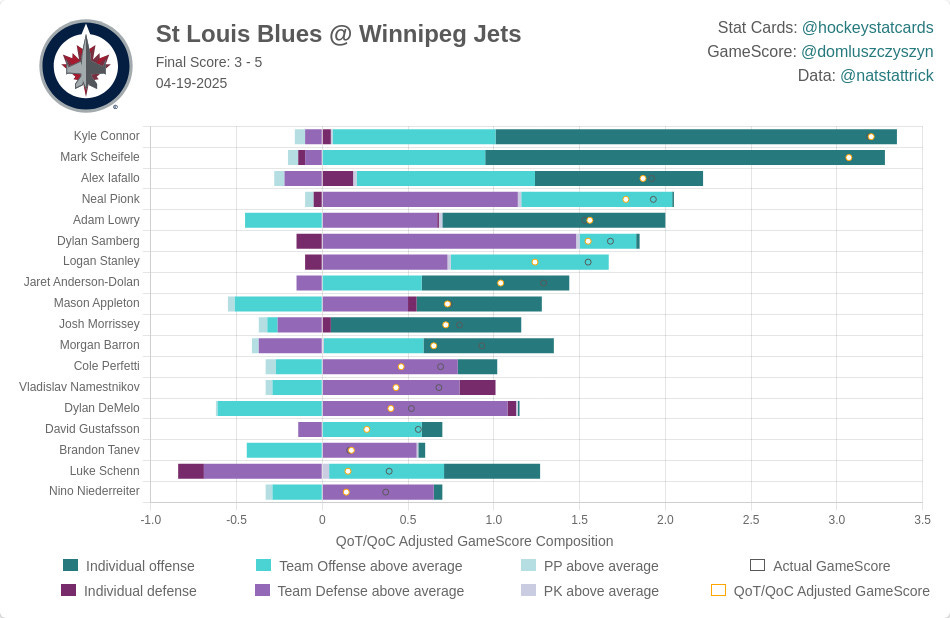The Winnipeg Jets won, and I’m sure no one reading this ever doubted them — and neither did I.
That said, the Jets played fairly well for the most part. Don’t get me wrong — there were definitely some ugly plays and mistakes. However, the Jets were overall better than their mistakes, and they deserved the win.
Let’s take a peek.
That’s pretty one-sided and consistent, other than a few small moments in the first — and, of course, the stretch when the Jets allowed the Blues’ second and third goals. And, as I’ll show way later, a much more promising underlying results performance than the previous post-season’s win.
It wasn’t a picture-perfect performance. The Jets lost the special teams battle 1–2. Their best player — Connor Hellebuyck — wasn’t his usual dominant self. And nearly everyone on the team had a few questionable moments.
Still, at 5v5, the Jets controlled play and got scoring from three of their four lines. Interestingly, when the game was close, the Jets preferred to double-shift Josh Morrissey or Dylan Samberg with Luke Schenn rather than Schenn’s actual defensive partner, Logan Stanley.
It seems like the team is dressing Stanley as an “expendable grit piece” they don’t fully trust for on-ice performance.
Which — looking at the numbers — was a weird but smart decision.
Look! Stanley is in the good section!! I think it was the worst 95% expected goal performance I’ve ever seen.
I’ll dive into microstats after the paywall, but…
Of the Jets’ thirteen failed 5v5 exits (eleven if you exclude Hellebuyck), six came from the bottom pair — and four of those were Stanley. The Jets had eight failed 5v5 defensive zone puck retrievals off Blues dump-ins — five came from the bottom pair, and three were Stanley.
So how do you deal with that discrepancy? There are two possible explanations:
Stanley — and to a lesser extent Schenn — actually performed very well, but mostly in areas not accounted for in the microstats I tracked.
Stanley — and to a lesser extent Schenn — actually performed terribly, but the Jets’ other skaters made up for the bottom pair’s mistakes.
Both are totally plausible, and I’ll let you decide which one seems more likely.
One thing to note when it comes to small-sample results: certain lines are heavily tied to specific pairings.
The Jets’ top line and top pair were joined at the hip, as were the Samberg pair and Lowry line. The Schenn/Stanley pair skated mostly with the Namestnikov line.
This is why shot metrics really start to matter over 10+ game samples — and ideally, at 20+ games.
I’m not the hugest fan of the gamescore model beyond casual intrigue. It feels heavily driven by usage and PDO, and I’m especially skeptical of the QoT/QoC adjustments, which seem way too uniform, way too often. Still, it gives you a rough single-game estimate.
That said, I don’t think anyone would argue against the top line having a major impact this game, considering they scored both the tying and game-winning goals.
All in all, it was a decent game. Despite some ugly moments and obvious issues, the Jets were clearly the better team — and they came out on top against St. Louis even in a weaker game from their star netminder.
The Jets won their first playoff game again — but this time, it was a much better team performance than last year’s.
Now to the fun microstats for our paid subscribers…
Keep reading with a 7-day free trial
Subscribe to The Five Hohl to keep reading this post and get 7 days of free access to the full post archives.









